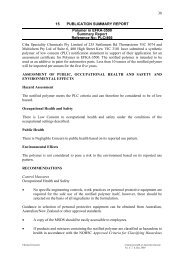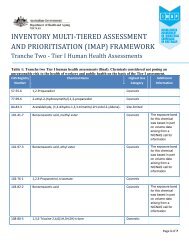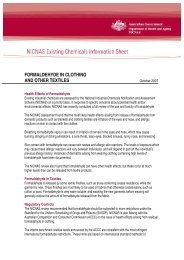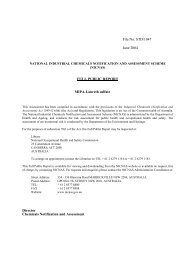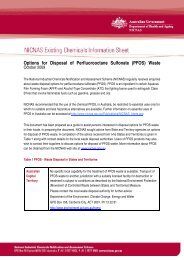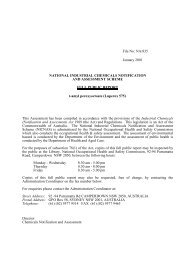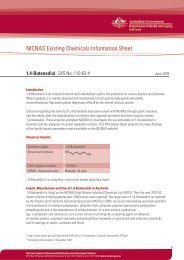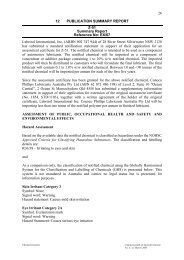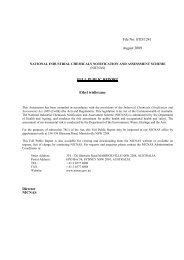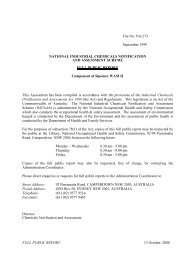GULFTENE C16-18 ISOMERISED OLEFINS - NICNAS
GULFTENE C16-18 ISOMERISED OLEFINS - NICNAS
GULFTENE C16-18 ISOMERISED OLEFINS - NICNAS
Create successful ePaper yourself
Turn your PDF publications into a flip-book with our unique Google optimized e-Paper software.
5. USE VOLUME AND FORMULATION<br />
Use<br />
Gulftene 16-<strong>18</strong> is to be used as a base fluid for invert drilling mud on offshore oil and natural<br />
gas drilling operations.<br />
Volume and Transport<br />
Gulftene 16-<strong>18</strong> will not be manufactured in Australia, but will be imported in liquid form by<br />
sea in 200 L drums or 8 000 L marine isotanks. Drums are loaded into a container (78 drums<br />
per container) prior to shipment. Over the next five years the anticipated import volume of<br />
Gulftene 16-<strong>18</strong> is up to 700 tonnes per annum. An annual import of 700 tonnes, (with a<br />
specific gravity of 0.8) equates to 900 000 L of Gulftene 16-<strong>18</strong> and would require the<br />
importation of 4 500 drums, or 110 marine isotanks per annum. The notifier indicated that<br />
imports may exceed 700 tonnes per annum, but could not predict exact volumes.<br />
The quantity of drilling mud used in drilling the wells depends on drilling depth and number<br />
of holes drilled. The notifier indicated that a typical oil/gas drilling platform may use 150<br />
tonnes of Gulftene 16-<strong>18</strong> annually.<br />
From the initial port of arrival the drums or isotanks containing Gulftene 16-<strong>18</strong> are delivered<br />
by truck to a storage and drilling mud blending facility. The prepared drilling mud is<br />
transported by tanker truck to docks, pumped into storage tanks on ships, then transported to<br />
the offshore platform. Up to 300 m 3 of drilling mud may be transported to the platform. The<br />
transfer of the mud from the ship to storage tanks on the platform is effected using special<br />
hoses and couplings.<br />
Formulation<br />
The drilling mud will be prepared at purpose built facilities at Dampier in WA.<br />
Gulftene 16-<strong>18</strong> will be blended at 33-50% with water, emulsifiers, fluid loss additives,<br />
viscosity modifiers and barium sulphate 1 in high shear mixers and pumped to an onsite<br />
storage tank. While no details were provided in the submission, it is understood that the<br />
facilities at which drilling mud is prepared are provided with adequate bunds to contain spills.<br />
All spilt material would be disposed of by incineration or by other accepted methods.<br />
Drilling Operations<br />
During drilling operations, the mud is pumped down the drill shaft. It functions as a lubricant<br />
for the drills and a carrier fluid for removing the solid cuttings (ie the rock removed from the<br />
bore hole). Drilling mud is pumped down the centre of the (hollow) drilling rods and is<br />
extruded through holes in the cutting head, which is of larger bore than the shaft of drilling<br />
rods. The mud then fills the annular region between the bore hole (typically 31.1 cm in<br />
diameter (Cobby 1999) and the drilling shaft, and as it is pushed back towards the surface<br />
carries the drill cuttings with it. The solid cuttings are separated from the fluid mud through a<br />
series of solids separation units. The cuttings may contain up to 10% (w/w) of Gulftene 16-<br />
1 The barium sulphate is used as a weighing agent to increase the density of the drilling fluid and control<br />
formation pressures in the wellbore during drilling operations.<br />
FULL PUBLIC REPORT 26 April 2000<br />
NA/713 Page 8 of 100



